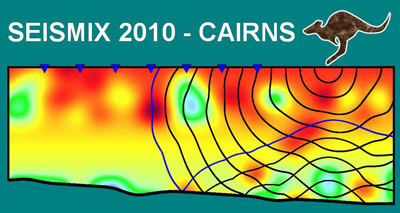Crustal Architecture and Images

|
IGCP Project 559
Crustal Architecture and Images |
 |
|
contact us: contact@earthscrust.org.au | about us
|
|
34th International
|
Updated: Dec 09, 2024 International Symposiums on the Seismic Probing of the Continents and their MarginsSince 1984 there has been 13 International Symposiums as a result of IGCP Projects 474 and 559. The next (14th) Symposium is to be held in Australia in 2010 (Seismix 2010). Previous SymposiumsSeismix 2012
15th International Symposium on the Seismic Probing of the Continents and their Margins
China 2012 Symposium Date:The current proposed date for Seismix 2010 is between August and September 2010, depending on northern hemisphere calendars and access to suitable venues in Cairns. A post Symposium geological/geophysical excursion will be arranged immediately after the symposium. Symposium Location:The proposed location for Seismix 2012 is Cairns, Queensland, Australia; or a suitable venue nearby Cairns. Cairns is located in tropical north Queensland and is a major tourist hub that services visitors to the Great Barrier Reef, the Daintree Rainforest World Heritage Area and the vast north Queensland hinterland regions. Around August and September, Cairns is hot. Its average annual maximum temperature for this period is 26°C to 27°C whereas its average minimum temperature is 17°C to 18°C. Average annual humidity of around 62% and therefore it's one of the balmiest cities in Australia. Cairns’ dry season runs from June to October where the average monthly rainfall is 35 mm. There are many websites providing information about Cairns and its surrounds. Below are a few to start: Symposium Transport:Cairns has an international airport that is serviced from a number of major Asian airports. In addition, Cairns has regular and frequent daily domestic flights to and from all Australian capital cities including other major international airports in Brisbane, Sydney, Melbourne and Perth. Symposium Venue:A venue is being chosen that will cater for both the symposium as well as providing accommodation and meals for the participants. Further information will be provided. Symposium Organisers:Symposium Committee
The committee will coopt additional members as required. Symposium Sponsors:Financial sponsorship has already been obtained from:
and in-kind sponsorship from:
The committee is investigating additional sponsorship. Symposium Format and Theme Description:The Symposium will keep with previous symposium tradition and will have both oral presentations with single sessions and poster sessions with time for presenters to discuss their results. The focus of the Symposium will continue to be on investigations into the continents and their margins using seismic techniques, as well as on details of the various (active and passive) acquisition, processing, and integration methodologies, including integration with other earth imaging datasets. The Symposium will encourage papers and posters on application of seismic methods in new areas including:
These will continue to be growth areas as the world begins to rely on earth imaging techniques to solve their resource and environmental problems. The Symposium themes will be similar to previous years, including but are not limited to:
Pre and Post Symposium Opportunities:Participants may wish to arrive in Cairns early or extend their stay after the symposium and field trip to take the opportunity to see some of the region’s famous attractions. Options include trips to the Great Barrier Reef, the Atherton Tableland, and the Daintree Forest World Heritage Area. Visit the above websites for further information. Wednesday Mid Symposium Excursion:Options are currently being considered for a suitable Mid Symposium Excursion. Suggestions being investigated include:
Post Symposium Excursion:The committee is planning a four day excursion immediately after the Symposium. This excursion would depart Cairns by bus and drive through Palaeozoic rocks of the Atherton Tableland hinterland, then along the 2006 Deep Seismic transect that crosses the Tasman Line, a major north-south geological structure extending for thousands of kilometres through the Australian mainland and separating the Australian Palaeozoic rocks from the Proterozoic rocks further to the west, then onto the Georgetown Province. The Tasman Line structure continues to provide much debate amongst geologists as to its significance. The excursion will then visit sites showing some of Australia’s youngest volcanism. The excursion will end in Cairns. Symposium Communications:Symposium communications will be through a series of circulars known past Seismix attendants, the Symposiums general email address Seismix10@ga.gov.au and this Symposium website. This website will provide information and registration. Symposium Logo:The symposium’s logo depicts an Australian kangaroo creating seismic waves through a laterally varying structure. Symposium Abstracts:Geoscience Australia, as Australia’s national geological survey, will publish the abstract volume in its Records series in order to ensure that authors have a citeable and enduring reference for tracking purposes. The symposium abstract volume will be produced prior to the Symposium and distributed to the participants on arrival at registrationSymposium Proceedings Volume:There will be an opportunity to publish the Symposium proceedings as a Symposium Volume, probably through Tectonophysics (though this publisher has not been approached). Suitable editors will be selected from the organising committee and coopted experts. Symposium Contact: Dr Bruce Goleby Phone: +61 2 6249 9404
|
| Disclaimer | Copyright | |